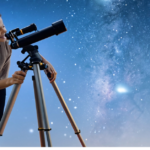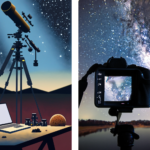Table of Contents
In this post, I want to help you if you are looking for the best telescope to buy, whether you’re looking to buy one for yourself or for someone else interested in astronomy.
There are many things we will need to consider when deciding what is the best telescope available today. Here are some of the most important things you need to think about before deciding what the best telescope is for you:
- What do you plan to use the telescope for?
- What kind of astronomical targets do you want to view or photograph?
- How much do you want to spend?
- Are you a beginner or more advanced astronomer?
- Where will you use the telescope?
- How do you plan to store the telescope?
Ok, so let’s look at each of these in turn, and I will make some recommendations on possible answers to your question, “What is the best telescope for me?”

How to Choose the Best Telescope
Before we look at the details of what kind of telescope you need and before considering each of the points above, let’s go over a few general facts about different types of telescopes.
The Most Popular Choices: The Best Amateur Telescope
Here are some facts I have managed to find regarding the different kinds of telescopes and the general choices you are faced with when looking for the best amateur telescope.
Over 50% of amateur astronomers prefer refractor telescopes for their superior image quality.
This figure, I think, would be lower for those astronomers who wish to do astrophotography, as I believe that, like myself, many astrophotographers use reflectors. I know that reflectors are much cheaper than refractors and are quite practical. In my experience, reflectors are also easy to use for astrophotography and for observing. This seems to show that the best amateur telescope, according to many, is a refractor.
Roughly 30% of stargazers opt for reflector telescopes due to their affordability and versatility.
The only downside of reflectors compared to refractors is that they need to be collimated regularly, but I have always found this to be quite easy to do. Despite what we said above about the popularity of refractors, many do consider a reflector to be the best amateur telescope to use.
Around 20% of users choose compound telescopes for their compact size and dual functionality
A compound telescope is one that uses a different method of construction and design so that it becomes more portable and compact. One example of this type of telescope is the catadioptric telescope. This is sometimes shortened to cat.
Nearly 70% of beginners prefer telescopes with computerised or GoTo mounts for easy navigation.
I use a Goto telescope and have always done so since the beginning, as it makes finding targets easier and quicker and simplifies tracking and setup. When technology is available, why not use it? For the amateur, the Goto system seems to have real practical benefits. I have a telescope with a Goto system and wouldn’t be without it!
Close to 80% of users consider aperture size to be the most important factor when buying a telescope.
The size of the aperture is crucial because it affects how much light the telescope can gather and, consequently, how well it can see details. Aperture is either given in mm or in inches. Generally, a larger aperture means that you will be able to see fainter objects and more distant ones with greater clarity. This will also improve the images you are able to take with a camera. However, aperture is not always a guarantee of the best telescope, as there are other things to look at, such as the quality of the optics.
Around 50% of users consider the telescope’s focal length as a key factor in their purchase decision
The focal length of a telescope will determine your field of view and how big or small an object will appear when you view or photograph it through your telescope. For smaller objects such as planets, distant galaxies, or planetary nebulae, a longer focal length, say more than 1000 mm, would be best, while for larger objects such as the North American or Seagull Nebula or the Andromeda Galaxy, the best telescope would have a shorter focal length of say 300mm or less.
Here is a fantastic telescope for viewing planets:
Here, I explain more about how to choose the best focal length for astrophotography.
Nearly 90% of users believe that a sturdy and reliable mount is crucial for a good stargazing experience.
Most astrophotographers and astronomers agree that the telescope mount is one of the most important pieces of equipment you need. If you are going to spend money on a mount, get the best one you can afford.
The telescope mount provides a sturdy base and a way to locate and track the object you are trying to view or photograph. When choosing the best telescope, you’ll also need to consider the telescope mount you will use, and, in some cases, you can buy the telescope and mount together in one package.
Ok, now that we’ve talked about some of the more general points that determine which is the best telescope for your needs, we’ll look at the specific factors that the best telescopes have.
Factors to Consider When Buying a Good Telescope
Let’s now look in more detail at the factors for choosing the best telescope given above at the beginning of this article.
What do you plan to use the telescope for?
There are a couple of different choices here. Do you want to use the telescope for viewing objects only, or do you plan to use it for astrophotography? Not all telescopes are suitable for astrophotography, and many telescopes need to be modified so that you can focus a camera attached to the telescope. Find out how to modify a telescope when you cannot focus your camera.
This one of the best value telescope OTAs for astrophotography:
What kind of astronomical targets do you want to view or photograph?
Once you know whether you’ll use your telescope for astrophotography or not, you’ll need to think about the kind of astronomical targets you plan to focus on. Do you want to view or photograph planets, galaxies, or deep-sky objects such as nebulae? Learn more about the best telescope for viewing planets.
For viewing Dobsonian telescopes like this one are fantastic:
A note here: many astrophotographers like to take photographs of the Milky Way or other shots of the sky and perhaps include landscape features in their pictures. You do not need a telescope for this kind of astrophotography. A DSLR camera and a suitable lens are used instead of a telescope. If you are interested in this kind of astrophotography, you can learn more about photographing the Milky Way or landscape astrophotography here.
Back to our discussion. The kind of targets you want to concentrate on will determine the best telescope for this because you may need a larger or smaller focal length or a different type of telescope.
For this reason, on this page, I will suggest the best telescopes for these different uses. The best telescope for viewing or photographing planets will be quite different from the best telescope for deep-sky astrophotography, for example.
How much do you want to spend?
Another important question to answer is how much money you want to spend on a telescope. The very best telescopes are expensive, but that doesn’t mean you can’t get something for much less. The best telescope for you is the one you will use often and the one you can afford.
There is no limit on the amount that could be spent on a telescope. Most amateur astronomers have a limit to what they can spend. Only the likes of Nasa can afford to spend billions on a telescope!
For a beginner telescope, you would need to spend a minimum of 200–400 dollars. If you spend 500 to 600 dollars, you can get a larger aperture, which can be useful. For good-quality astrophotography, you need to look at at least 800-1000 dollars, which would include a telescope with a good equatorial mount.
There are even higher-priced telescopes, depending on the quality you want to buy. More advanced telescope users who want the very best telescope may pay as much as $10,000.
So deciding on your budget is a good start in your hunt for the best telescope you can buy.
Are you a beginner or a more advanced astronomer?
As we have seen above, a beginner doesn’t need such expensive equipment. There is no point in spending more if your knowledge of astronomy and telescopes is limited, as you won’t be able to take advantage of the extra features or quality that your equipment has. More expensive equipment may just confuse you and cause you more problems than using something more basic and easier to use.
As your level of astronomy or astrophotography experience increases, so will your need for better equipment. You’ll understand more about how more professional telescopes can help improve your viewing or astrophotography.
For these reasons, the best telescope for a beginner is very different from the best telescope for an intermediate or advanced user.
Where will you use the telescope?
There are at least two reasons why you need to consider this question. Where you intend to use the telescope will determine how portable it needs to be. Will you have a permanent setup, or will you need to move it or transport it?
More expensive and higher-quality mounts and telescope tubes are usually bigger and heavier. Buy something compact and lighter if you plan to use it in different locations.
The second reason why you should consider where you plan to use your telescope is because of light pollution. This changes with location, so do you plan to use your telescope near or in a city with high levels of light pollution or from a rural location with lower levels of light pollution?
Light pollution affects how you view and photograph night sky objects. Learn more about light pollution and its effects on astronomy and astrophotography.
How do you plan to store the telescope?
Don’t forget, you’ll need to store your telescope. How much space do you have? Where will you keep it? It will need a dry and safe place to stay. If you are short on space, don’t get a large telescope.
I conducted some research and after a great deal of thought put together this list of the best telescopes for 2024:
Best Easy entry beginner viewing telescope:
Best Smart Scope – Ultimate Convenience and Quality
Best Astrophotography Telescope Refractor at a Low Price
Explore Scientific ED127 refractor telescope











